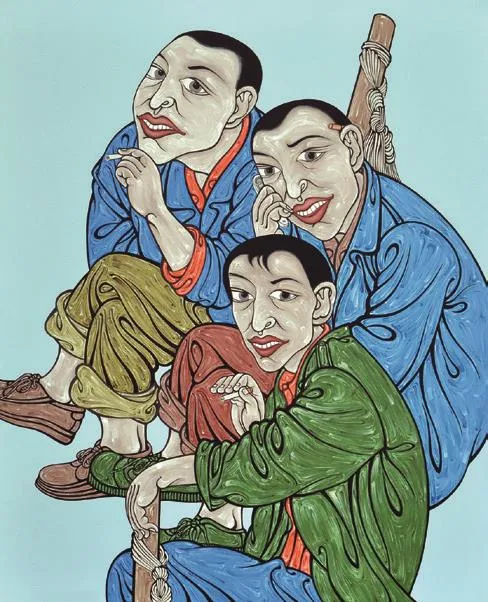黄山:落笔草根
2018-03-02陈科龙刘映呈受访者提供
◇ 文| 本刊记者 陈科龙 图| 刘映呈 受访者提供
黄山记得很清楚,八年前的那个冬天似乎格外冷。一天夜里,他走在解放碑街头,一阵风吹来,他下意识地紧了紧皮夹克的衣领。
忽然,一个黑乎乎的角落里亮起一点星火,拽住了他的目光——一个“棒棒”(挑夫、力哥,编者注)坐在花坛边上,翘着二郎腿,手中打火机微弱的火光,照亮了他微微佝偻的身躯……
黄山站在路边,愣是悄悄看着他抽完了整支香烟。
Huang Shan remembers very clearly, that eight years ago, it was an extremely cold winter. One night, he was walking in the streets of Jie Fangbei. A gust of wind blew, and he subconsciously tightened his leather jacket collar.
Suddenly, a little spark lighting up in a dark corner grabbed his eyes. A “Bang Bang” (porters or stick men) sat on the edge of the flower bed with his legs crossed. Flame of the lighter in his hand revealed his slightly stooped figure.
Huang Shan stood over the road and quietly saw the porter smoking the whole cigarette.
发现另一种常态 Finding Another Normalcy
“周围是万家灯火,他抽烟的形象,一直印在我脑中。”这个冬天,我们在四川美术学院虎溪公社见到了黄山。他身上也是一件皮夹克,只是有些宽大,包裹着他清瘦的身材,头发蓬松、灰白。他似乎总是一脸严肃,若有所思。
打那个冬夜起,他的目光几乎锁定了这群普通人。

黄山 黄丹《茶馆系列之二》130X90cm综合材料 2014年

棒棒日记2 120X120cm 布面丙烯 2011

棒棒日记3 120cmX120cm 布面丙烯 2011

棒棒日记7 110x90cm布面丙烯2012
在他工作室的墙沿下,堆满了人物画。一幅表现“山城棒棒”的作品,色彩鲜明,独树一帜。这是黄山创作的《棒棒日记》系列中第七幅作品。画面中三个挑夫,挽着裤腿和衣袖,蹲在一起,其中两个抽着烟,另一个在打电话。
“不要以为他们在休闲享受,其实是在无奈与无聊中打发时间,”黄山的话刚起头,又连忙从地上堆着的书里找出了他的中国画作品选递给我们,里面有7幅《棒棒日记》,其中6幅里画的挑夫都蹲坐在一起,要么抽烟,要么打牌,要么发呆。
印象中描绘挑夫的画面,总是挑着重重的担子爬坡上坎,大汗淋漓、青筋暴露。而黄山眼中,“等待”才是挑夫们的人生常态,他们习惯等待,在四周熟视无睹的目光中等待。
画中,力哥们身后常有着光鲜亮丽的女性形象。“我想通过她们,与‘棒棒’形成强烈的对比,反衬出一种无奈。”黄山特意说明。
“Around him are lights of the city, so the image of him smoking alone is always in my mind.” Huang Shan said. This winter, we met him in Huxi Art Commune of Sichuan Fine Arts Institute. He also wears a leather jacket, but a little bit loose, wrapping his thin body. With fluffy and gray hair, he always seemed to be serious and thoughtful.
From that winter night on, Huang Shan’s eyes were almost fixed on those ordinary people.
In his studio, many figure paintings pile up along the wall. One of the paintings depicting “Bang Bang” in mountain city stands out with bright colors. This is the seventh work in the series of “Bang Bang Diary” produced by Huang Shan. Three men in the picture, with their trousers and sleeves rolled up, squatted together, two of them smoking cigarette and one on the phone.
“Do not think that they were relaxing, they were actually killing time.” Huang Shan said and hurriedly found his Selected Works of Chinese Painting from piled books on the floor and passed it to us. There are seven “Bang Bang Diary” and in the six pictures of them, porters all squatted together, either smoking, or playing cards or in a daze.
Under the impression, porters in pictures are always carrying heavy load while climbing up the hill, sweating and veins twitching, but in Huang Shan’s eyes, waiting is their normalcy. They are used to waiting and always wait in the blind eyes.

黄山 黄丹 《祥和-巴渝村镇即景》133x170.5cm综合材料 2014
In the paintings, behind porters are usually glamorous female images. “Through them, I make a striking contrast to express helplessness.” Huang Shan specified..
唱着凡人歌作画 Singing Mortal Song and Painting
为挑夫作画,并不是黄山艺术生涯中的偶然。
他从小在乐山长大,小学四年级被迫辍学。两个哥哥下乡当了知青,黄山因“留身边”的政策,待在了父母身边。
“那个时候,我要烧火做饭,还要捡煤渣,没事就在家里读妈妈或买或借来的鲁迅的杂文、诗歌。”他点上一支烟,“邻居有个美术教员叫罗顺贵,我整天泡在他家看列宾和黄宾虹画册,请他教我画画。”
稍大一些,父母让他到乡下学了一年木匠。“我也是吃过‘捡水’的。”那时,农村没有水管,接水得用一截一截劈开的竹筒,把水引到家里的水缸。在木匠家,黄山一有空隙就悄悄画画,画村里的人,画村里的景。
回到乐山城里,黄山又去杂技团当临时工,在粮油公司当售货员。
他一心想考四川美术学院。1977年,报考川美附中未果,第二年又报考川美,失败了。1979年,他在辽宁锦西当了兵,走进海军军营,在政治部宣传队里画布景、宣传栏、幻灯片,给战士画肖像画速写。两年的磨砺,绘画功底快速提升。1981年,退伍后,黄山终于踏入了川美校园,有幸师从冯建吾、萧建初、李文信、白德松等名家。
年轻时的经历使然,黄山的画笔始终落在草根之中,《棒棒日记》系列如此,《祥和·巴渝村镇即景》和《茶馆》系列也是如此。
It is not by accident that Huang Shan chose to paint for the porter.
He grew up in Leshan and was forced to drop out of school in the fourth grade in primary school. Two elder brothers went to the countryside to be educated, and Huang Shan stayed with his parents because of “staying around” policy.
“At that time, I had to make a fire to cook and also pick up coal cinders. I would read Lu Xun’s essay and poems my mother bought and borrowed for me.” Huang Shan lit a cigarette and continued, “I had a neighbor Luo Shungui who is an art teacher, and I spent the whole day at his house looking at picture albums of Ilya Repin and Huang Binhong and asked him to teach me to paint.”
When Huang Shan grew elder, parents sent him to countryside to learn to be a carpenter for one year. “I also ate ‘Jian Shui’”. At that moment, the rural area lacked water pipes, so bamboo pipes were used to lead the water to the water tank at home. In the carpenter’s home, Huang Shan would paint people and views in the village when he was free.
Back to Leshan, Huangshan went to an acrobatic troupe as a temporary worker and also worked as a salesman in the grain and oil company.
Huang Shan was bent on being admitted to Sichuan Fine Arts Institute. In 1977, he took the entrance exam of Affiliated High School of Sichuan Fine Arts Institute but failed. Next year, he took the exam again and encountered failure again. In 1979, Huang Shan became a solider in Jinxi, Liaoning. He went to the marine barracks and in the propaganda team of the political department, and he painted settings, publicity columns and slides and sketched soldiers. Two years of honing, his painting skills received rapid promotion. In 1981, after leaving the army, Huang Shan finally stepped into the campus of Sichuan Fine Arts Institute and learnt to paint from Feng Jianwu, Xiao Jianchu, Li Wenxin, Bai Desong and other masters.
Previous experiences make Huang’s paintbrush always focus on the grassroots. “Bang Bang Diary” series, “Peace and villages and towns in Bayu” and “Teahouse” series all depict the grassroots.

《茶馆小记之四》纸本水墨90cm×48

《茶馆小记之五》纸本水墨90cm×48.5cm 2017

《茶馆小记之二》纸本水墨
洞见悲喜画时代 Seeing Joys and Sorrows and Painting the Time
《茶馆》是黄山新近创作的一组水墨画。为了创作,最近几年,他常常到綦江东溪古镇赶场。
“一碗茶,五角钱,就可以坐一天。茶馆里的人很平静,表情就写着朴实、真诚,揩嘴巴、掏耳朵都毫不掩饰。”黄山说自己就是草根,在他眼里,心里,农民、茶客等等都是可爱的,撩拨着他的艺术冲动。
有人认为水墨艺术是“自语自恋,疏离时代”,是令人抵触的“文人自适”,黄山不这么认为。“恰好是游戏时代下可贵的自语自恋,生动映照出世象的光怪陆离。水墨画透露出洁身自好的秉性和文化品格,远比那些‘主义’‘运动’纯粹自然。”
作为中国画的传承者,低调的黄山坦言他有一种使命感。作为人物画家,他的使命在于洞见和表现大众的喜与悲,挖掘生活的表面下,当代人物的真实面貌。“这也是在捍卫民族精神,传承文化。”美术评论家林木先生看过黄山的画展后,曾这样评价:“黄山是真诚的,他深刻理解了中国艺术的情感内核,那份诚挚源于对生活的真情,他把从普通人们生活中得来的激情物化于画中。”
“Teahouse” is Huang Shan’s newly produced series of ink paintings. He often went to Dongxi, the ancient town in Qijiang District to drink tea.
“A bowl of tea only costs half Yuan, so one can sit there for one day. People in the teahouse are calm, and their expressions show simplicity and sincerity. They wipe their mouths and clear ears publicly.” Huang Shan says he is one of the grassroots, and in his eyes, farmers and tea drinkers are lovely and they push his artistic creation.
Some people think that ink art is literati’s self talk and narcissism and alienates from the times, but Huang Shan does not think so. “It is precious self talk and narcissism that matters in the age of the game. It gives a vivid reflection of the bizarre and motley of the world.Ink paintings reveal integrity and the cultural character of nobility, much better than so-called ‘ism’ and‘movement’.”
As the heir of Chinese painting, Huang Shan is lowkey to admit that he has a sense of mission. As a painter,his mission is to see and express the joys and sorrows of the masses and excavate the surface of life and find the true face of contemporary people. “This is also defending national spirit and inheriting culture.” Huang Shan said.After seeing Huang Shan’s art exhibition, Lin Mu, an art critic once said, “Huang Shan is sincere and he has a deep understanding of Chinese art emotional kernel. The sincerity comes from true feelings towards life and Huang Shan puts those feelings into his paintings.”.
